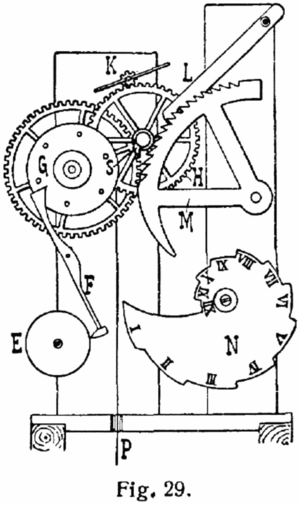Edward Barlow (priest) facts for kids
Quick facts for kids
Edward Barlow
|
|
|---|---|
| Born | 1639 |
| Died | 1719 (aged 79–80) |
| Nationality | English |
| Alma mater | English College, Lisbon |
| Occupation | Priest, mechanician |
| Parent(s) |
|
Edward Barlow, also known as Booth (born 1639, died 1719), was an English priest and a clever inventor. He was known for his skills in mechanics.
Contents
The Life of Edward Barlow
Edward Barlow was born in Warrington, Lancashire, England. He was baptized on December 15, 1639. His birth name was Edward Booth. He later took the name Barlow from his uncle, Father Ambrose Barlow. His uncle was a Benedictine monk.
Early Life and Studies
When Edward was twenty years old, he went to study at the English College at Lisbon in 1659. After becoming a priest, he returned to England. He lived with Lord Langdale in Yorkshire for a time. Later, he moved to Parkhall in Lancashire. His main job was helping poor people nearby. He lived simply, just like them. Edward Barlow died in 1719 when he was about 80 years old.
A Brilliant Mind
A church historian named Dodd knew Barlow personally. Dodd said that Barlow was very good at languages. He knew Latin, Greek, and some Hebrew. Dodd believed Barlow was naturally gifted in math and science. He didn't need to read many books on these subjects. It seemed like he just understood how things worked. Barlow once said that reading Euclid (a famous Greek mathematician) was as easy as reading a newspaper.
Barlow is remembered for inventing pendulum watches. However, like many inventors, he didn't get rich from his ideas. Others made money from his inventions. A clockmaker named Thomas Tompion found out about Barlow's work. Tompion then gave Barlow £200 as a gift. This was a lot of money back then!
Barlow's Clever Inventions
For a long time, people thought Edward Barlow invented a special part for clocks called the "rack and snail" mechanism. This part helps clocks strike the hours. However, his real invention was different. It was a way to make "repeater" clocks.
How Repeater Clocks Worked
Barlow's invention allowed clocks to tell the time in the dark. Before electric lights, this was very useful. You could pull a string on the clock. Then, it would strike the number of hours. This way, you knew the time without needing to see the clock face.
Repeating Watches
This clever invention was later used in pocket watches too. Edward Barlow and another London watchmaker, Daniel Quare, both claimed to have invented the repeating watch. They argued over who should get the patent rights.
In 1687, King James II decided to settle the argument. He asked each watchmaker to bring a "quarter repeater" watch. The king and his advisors would examine them. The king tried both watches. He preferred Daniel Quare's design. This news was announced in The London Gazette.
Barlow's vs. Quare's Design
The two inventions had a small difference. Barlow's watch repeated the time when you pushed two small parts on the sides of the watch. One part would strike the hour, and the other would strike the quarter-hour. Quare's watch worked with just one pin. You pressed this pin near the top of the watch. It would then repeat both the hour and the quarter-hour.
Barlow's Written Works
Edward Barlow also wrote several books. Here are some of them:
- Meteorological Essays: This book was about how springs start, how rain forms, and how wind is made. It also talked about the tides. It was published in London in 1715.
- An exact Survey of the Tide: This book explained how tides are made and how they move. It focused on tides near Great Britain and Ireland. It also included a section about springs, rain, and wind. This book had twelve interesting maps and was published in 1717. A second edition came out in 1722.


